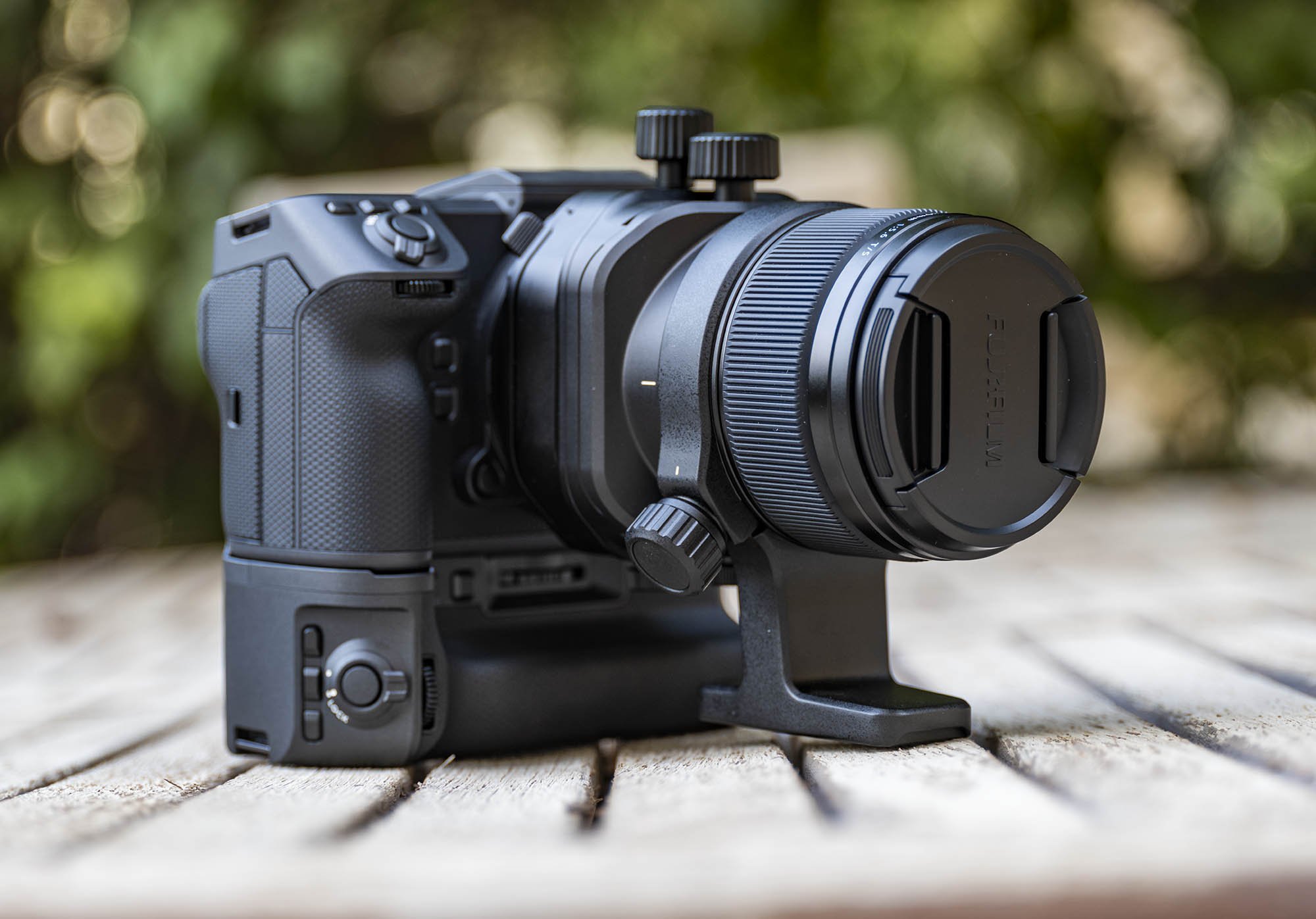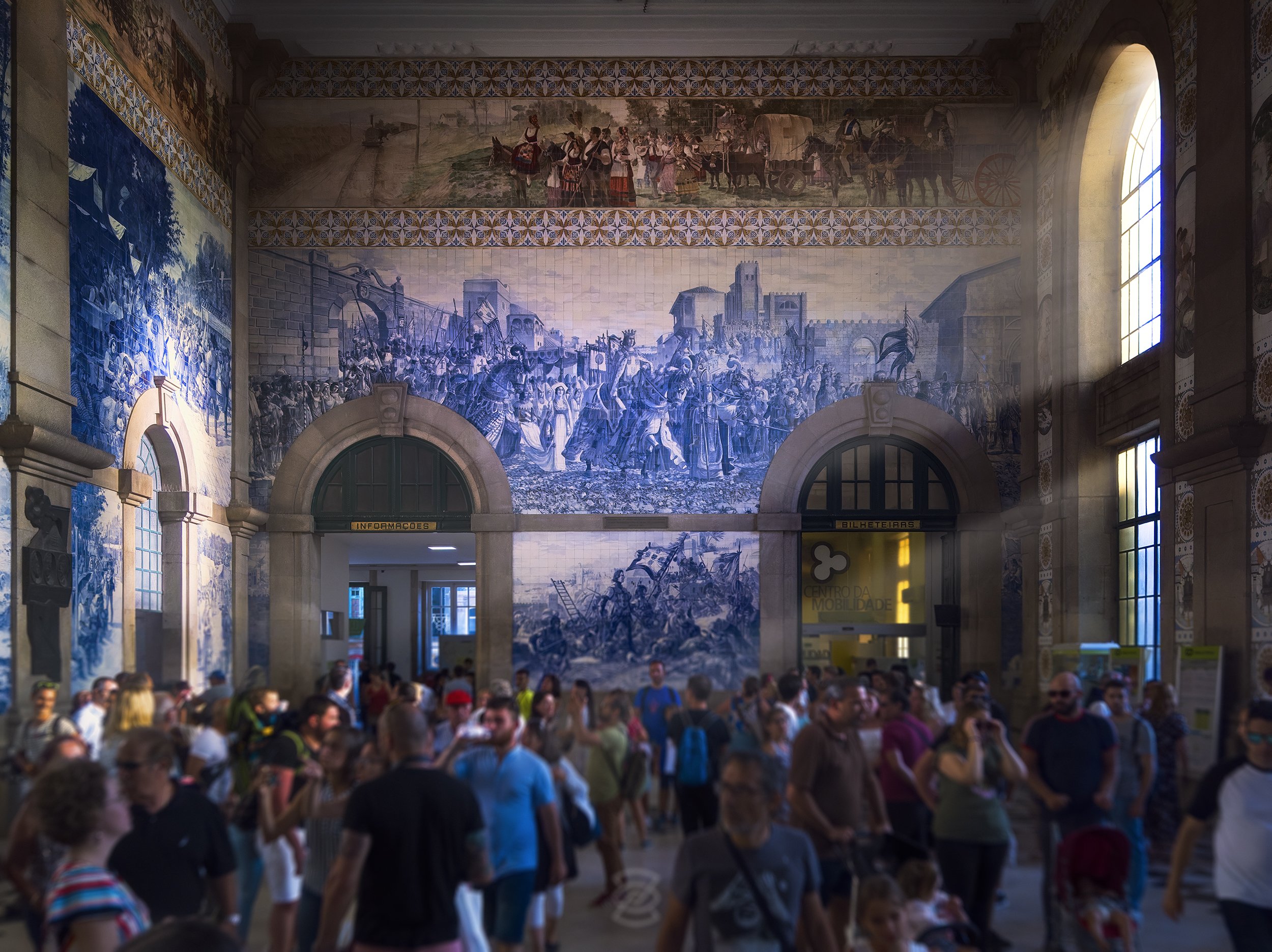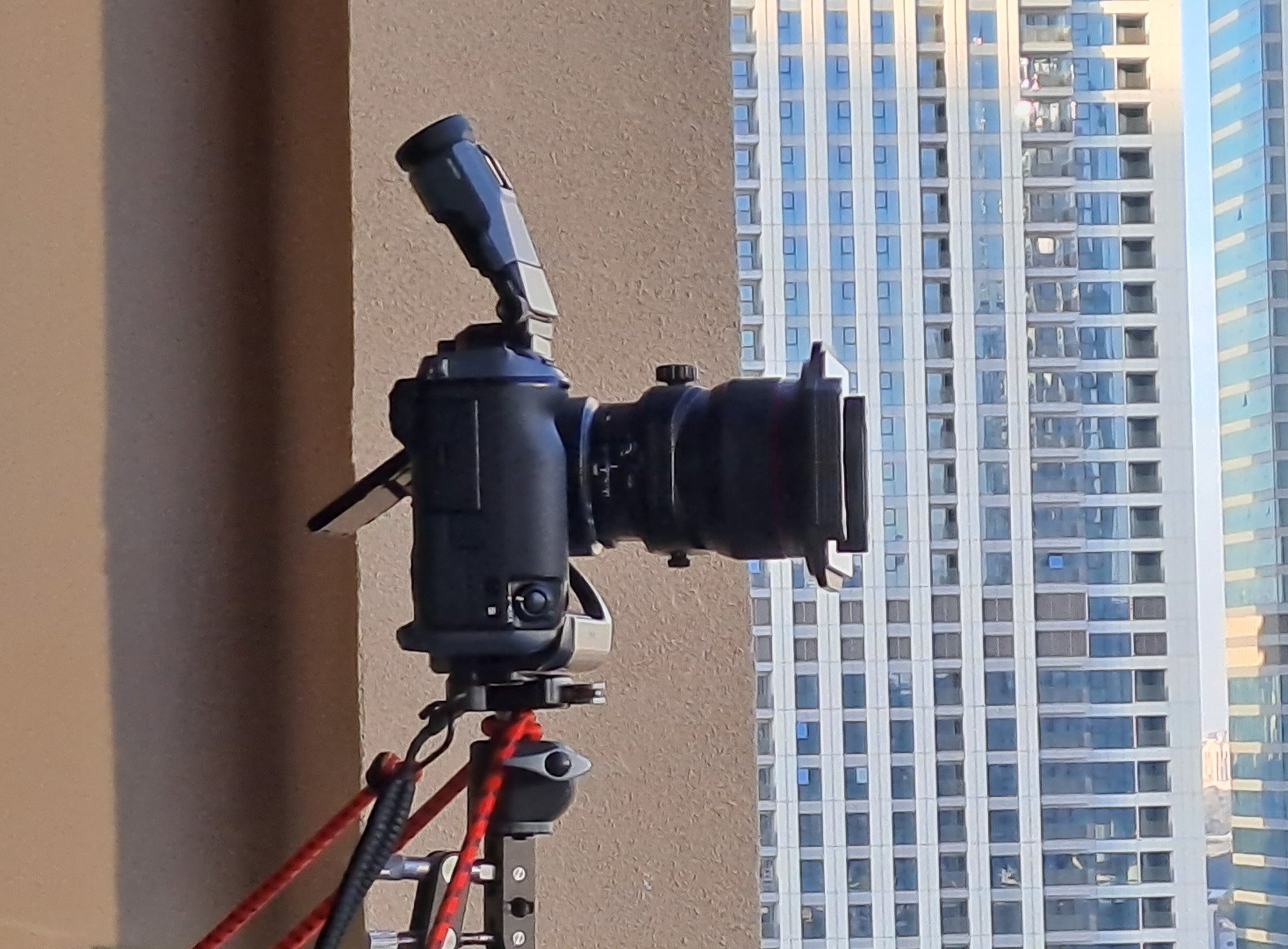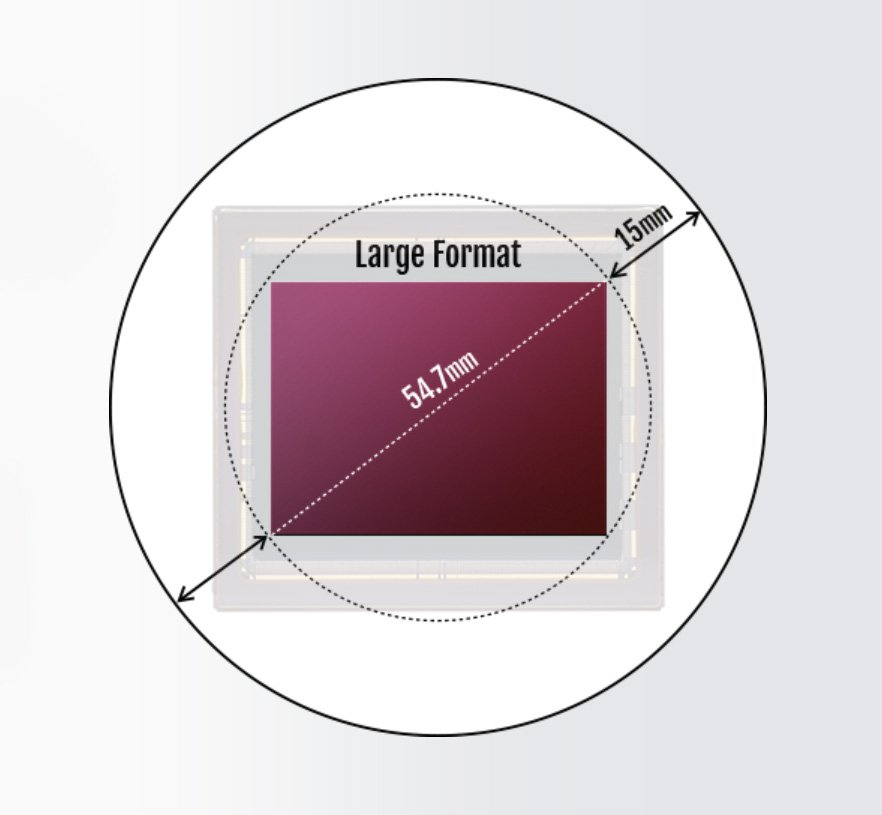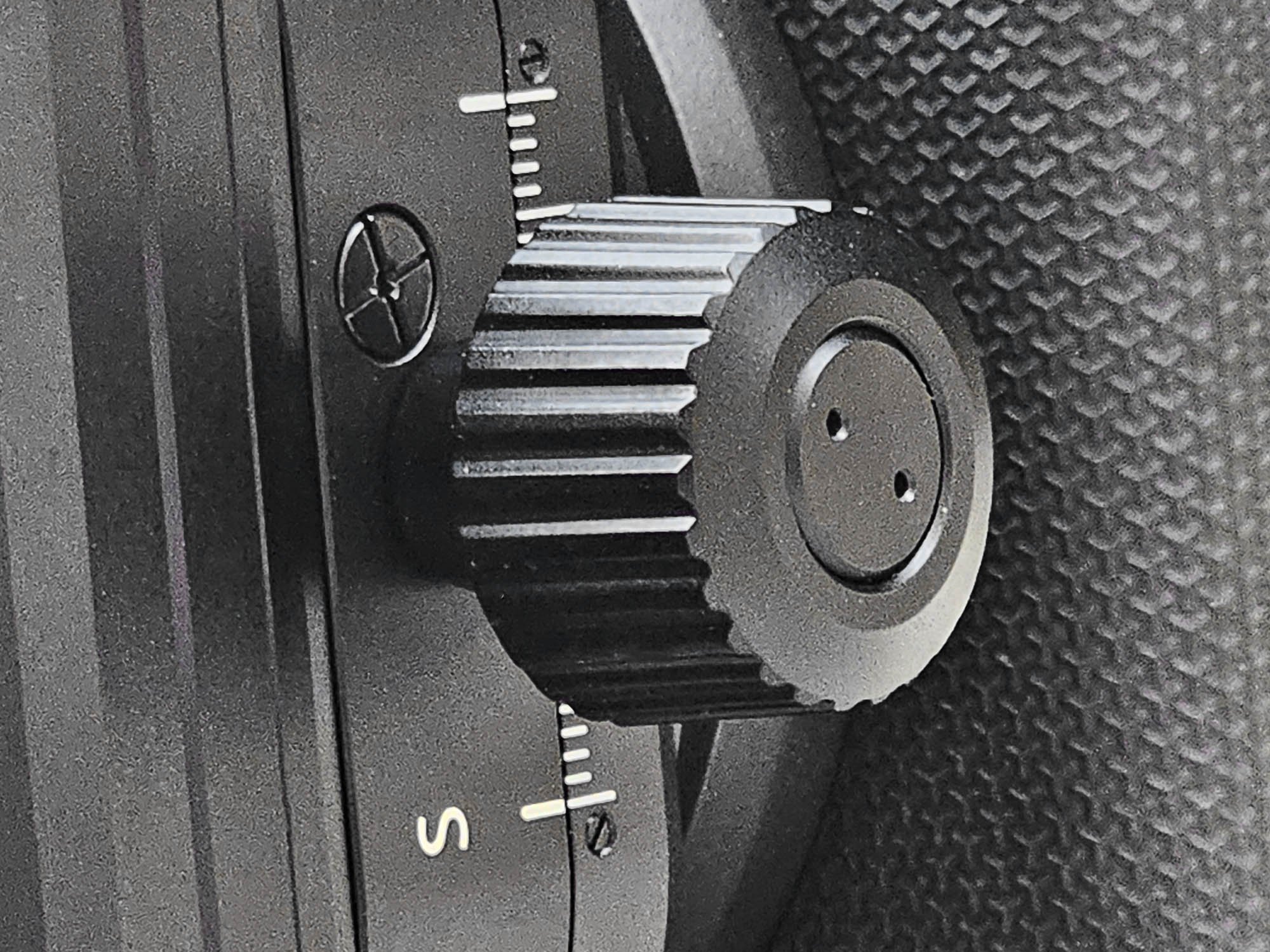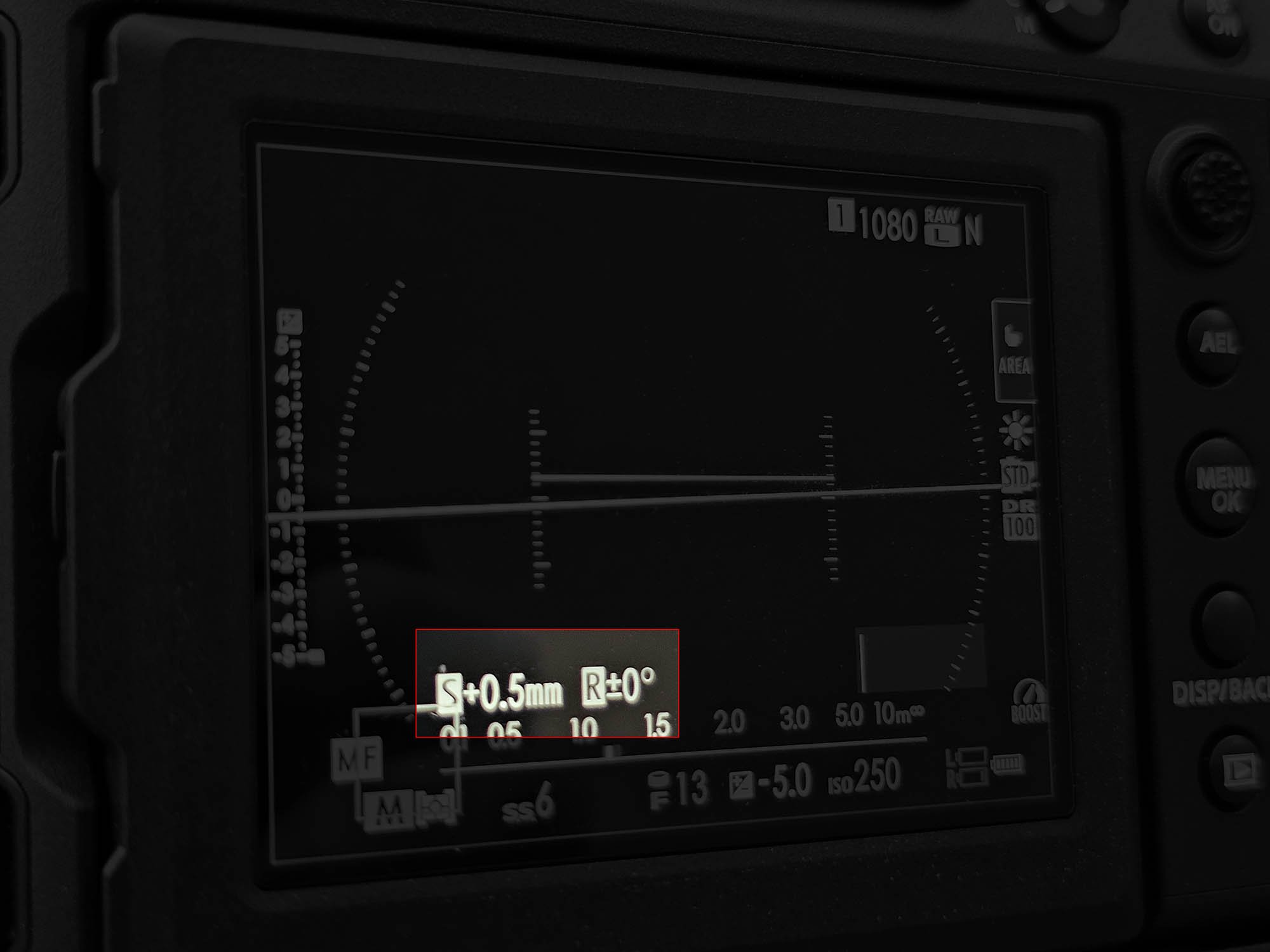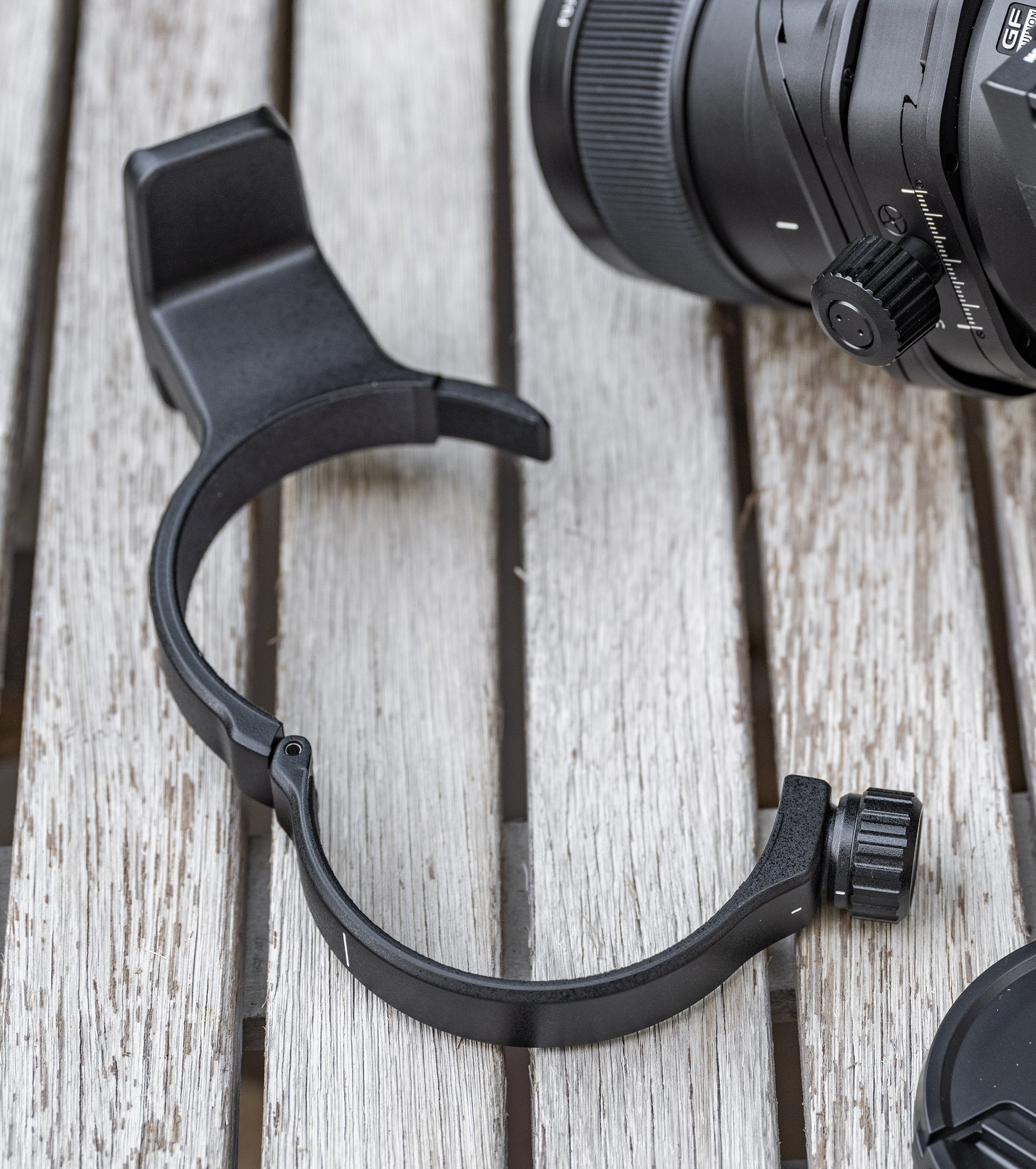The Ultimate Lens for Creative Photographers
See the world in a new way with this versatile and powerful tilt-shift lens
INTRODUCTION
I've been a photographer for a long time, but it wasn't until I started using tilt-shift lenses that I became obsessed with straight vertical lines. It’s not just a matter of aesthetics. It's about capturing the world as we see it. When we look at a building, it appears straight, regardless of whether we tilt our heads up or down. This is because our brains automatically compensate for the distortion caused by perspective. But cameras and lenses don't have this ability. If a camera is tilted up or down, the vertical lines in the image will converge, resulting in geometric deformation.
On the left: Building photographed with the Fujinon GF20-35 (regular) lens without perspective control. To capture the entire building, I had to tilt the camera upwards, which heavily distorted the building. On the right: The same building after perspective correction in post-production. It took a lot of effort and time to achieve this result, but some sharpness and resolution were lost in the process, and the proportions of the building are questionable.
SHIFTING FUNCTIONALITY
Tilt-shift lenses solve the problem of converging vertical lines by allowing photographers to raise or lower the horizon of the scene while the camera is perfectly leveled and parallel to the ground, without tilting the camera up or down. This is important, because architecture and interior photographers need to portray buildings and cityscapes as realistic as possible. They need to capture the world as we see it with our own eyes, with all its beauty and imperfections. And straight verticals are a key part of that objective.
In real life, straight verticals can also be symbolic. They represent stability and order. They give us a sense of place, scale and perspective. They help us to orient ourselves and to navigate the world around us. Converging lines in a photograph cause us to lose our sense of reality. The result is an unnatural, distorted, unsteady, and unbalanced feeling in the image. In order to capture the world in a way which engages the viewer more deeply, we need to straighten those verticals.
Here are some examples of how straight verticals can be used to create more realistic and engaging photographs:
Architecture: When photographing buildings, straight verticals can help to convey a sense of scale and grandeur. They can also be used to emphasize the symmetry and balance of a building's design.
Landscape: In landscape photography, straight verticals can be used to create a sense of depth and perspective. They can also be used to highlight the natural beauty of the landscape.
Portraits: When photographing people, straight verticals can help to create a sense of dignity and authority. They can also be used to flatter the subject's features.
Various subjects I've photographed over the years. Straight verticals are essential in architectural and interiors photography because they create a sense of order, balance, and realism. Professional photographers use a variety of techniques to achieve straight verticals, while amateurs may not be as aware of their importance or may not have the skills and equipment to achieve them.
Fujifilm GFX users, myself among them, have long been clamoring for native tilt-shift lenses, and their prayers have finally been answered. Tilt-shift lenses are a popular tool for medium format photographers, but until now, Fujifilm GFX users only had the option of using third-party tilt-shift lenses via an adapter. This was far from ideal, as these lenses weren't designed for medium format sensors and didn't deliver the best image quality.
Fujifilm GFX 100 with Canon TS-E 24mm II via Techart EF to GFX adapter. Not an ideal solution, but what choice did I have?
tilting functionality
To understand how the tilt functionality works, one must first understand “The Scheimpflug principle”, which describes the geometric connection between an optical system's focal plane, lens plane, and image plane. Numerous photographic techniques in the real world employ the Scheimpflug principle. It can be utilized, for instance, to:
Control the depth of field: The photographer can alter the depth of field in an image by tilting the lens. For instance, tilting the lens upwards can deepen the field, while tilting it downwards can shallow the field. This is helpful for many other types of photography, such as landscape, architectural, and portraiture.
Create a miniature effect: The photographer can create an illusion of a small world image by tilting the lens. This is accomplished by blurring the image's foreground and/or backdrop while maintaining sharp focus on the object. To provide the impression that the image is a small model, this method is frequently utilized in architectural and landscape photography.
By enabling the photographer to tilt the lens plane by 8.5 degrees, the Fujinon GF30mm T/S lens makes use of the tilt functionality. This gives the photographer control over the image's plane of focus.
Here are some of my photos where I’ve employed the lens’ tilt functionality to create a miniature effect. It’s particulary effective in the cityscapes, photographed from a vantage point.
The release of the Fujifilm GF30mm f/5.6 T/S and GF 110mm f/5.6 tilt-shift lenses is a major milestone for the GFX system. These lenses are specifically designed for the GFX system's 55mm large-format sensor and deliver exceptional image quality. Fujifilm GFX users now have access to native tilt-shift lenses that deliver the highest possible image quality. These lenses will open new creative possibilities for GFX users and help them to capture stunning images that were not possible before.
OPTICAL DESIGN
Fujifilm is one of the world's most experienced and respected lens manufacturers. Designing a tilt-shift lens for medium format cameras is a daunting task, as these lenses require the highest level of optical and mechanical precision. To ensure that the GF 30mm T/S lens would produce consistently superior images, Fujifilm created a complex optical design consisting of 16 lens elements in 11 groups. The lens includes 3 aspherical elements, 2 ED elements, and 1 Super ED element. This sophisticated design eliminates virtually all geometric and chromatic distortions.
The Fujifilm GFX 100 II has a large sensor, measuring a whopping 43.8 x 32.9mm. The image circle produced by the native tilt-shift lenses, the GF 30mm f/5.6 and GF 110mm f/5.6, is 85mm. This means that the lenses can cover the entire sensor of the GFX 100 II, even when tilted or shifted.
Fujifilm GF30mm T/S: Larger and Heavier, But Worth It
The Fujifilm GF30mm T/S lens has a large image circle to cover the medium format sensor of the Fujifilm GFX cameras. This results in a larger and heavier lens than the Canon TS-E 24mm II lens, which is designed for full-frame cameras. However, the Fujifilm GF30mm T/S lens is still relatively lightweight for a tilt-shift lens, and its excellent image quality is worth the extra weight.
Canon TSE-24 mm II on the left and right (786 grams). Fujinon GF30mm T/S in the middle (1340 grams)
WEATHER SEALING
There is no weather swing unfortunately, which is not surprising given the fact that these lenses have lots of mechanical articulation.
build quality
The GF 30mm f/5.6 tilt-shift lens uses CNC machined components from a single block of aluminium to ensure precision and accuracy. This is particularly important for tilt-shift lenses because of mechanical articulation involving precise rotation and sliding of individual parts. The lens barrel must obviously be perfectly round and concentric to produce high-quality images. No play is allowed between each component and tolerance must be kept to an absolute minimum for all optical elements to stay within ideal distances and relationships. The CNC machining process takes several hours to complete for each lens barrel, and this is why you can’t expect this lens to be produced in big quantities. It’s an exotic, niche product.
Oozing of high-quality workmanship and a long history of Japanese precision
IMAGE QUALITY
None of the above matters unless the lens produces sharp and distortion-free images. So I’ll get straight to the point; GF30mm F5.6 T/S is a spectacular lens and the images that come out of it, are pure marvel. You can stop reading here, and pre-order, or buy the lens. You won’t regret it.
From my tests, the photos do not exhibit any (visible) vignette, chromatic aberration, corner blurring or smudging, even at maximum shift, which is +/- 15mm at each extreme. Images are clinically sharp and free of any distortion. I opened the massive 16-bit, 200MB RAW files with the latest version of Photoshop with no issues. ACR module removed all optical flaws and imperfections on the fly. But how? Every Canon or Nikon T-S lens owner knows that you can’t use the RAW converter to automatically fix optical distortions. To answer why this is so hard to achieve, we must know the following first: Lightroom -can- fix optical imperfections and distortions from regular lenses because it has a database of lens profiles. These lens profiles contain information about the specific optical characteristics of each lens, including the types of distortion that it produces. Lightroom uses this information to automatically correct the image for distortion when you import it into the program.
To assess the quality of a lens, check the sharpness in the corners, not just in the center. This is especially important with tilt-shift lenses, as images taken in a fully shifted position can exhibit corner softness, exaggerated chromatic aberration, vignetting, and excessive stretching. The GF30mm T/S is the sharpest tilt-shift lens I have ever tested. Even in the most shifted parts of the image, there is absolutely no sign of image quality degradation. Textures are crisply detailed, edges are razor sharp, and I have literally nothing to complain about. The images look computer-generated, they are so flawless.
Left side: The full picture taken with maximum vertical shift (15mm upwards). 3 red squares indicate the 100% crops on the right side.
However, Lightroom does not have lens profiles for tilt-shift lenses. This is because tilt-shift lenses are more complex than regular lenses, and their optical characteristics can vary depending on how they are tilted and shifted. This movement can change the optical characteristics of the lens, which can make it difficult to create accurate lens profiles. As a result, Lightroom cannot automatically correct tilt-shift lens distortion. Despite these challenges, there are some applications that can be used to correct tilt-shift lens distortion. These programs typically use a combination of manual and automatic tools to correct the distortion. But they aren’t perfect, and it will take some experimentation to get satisfactory results.
GF30mm T/S lens has built-in digital sensor measuring the amount of lens rotation and shift which is displayed on the LCD. I loved this feature - it’s totally unique!
But the GF30mm T/S lens is special with unique technology! It tracks and records the shift and rotation data by using a series of sensors inside the lens. The lens always knows where the center of the image circle is when a picture is taken. The data is then transmitted to the camera body, where it is stored in the RAW image file. When you import a RAW image file into a program like Lightroom, the program reads the shift and rotation data to automatically correct image distortion. This is done by using the information in the lens profile to create a transformation matrix that is applied to the image. The transformation matrix corrects the distortion caused by the tilt and shift of the lens. It’s highly effective too. The images captured with GF30mm T/S are, simply put, flawless.
I was also impressed with bokeh this lens produces. It’s not something I was expecting or hoping from such a technical lens, but when I saw how perfectly round and smooth the defocused sparkles of the chandelier at the Sheikh Zayed Grand Mosque looked like, I was utterly charmed. I will consider shooting at widest apertures with the subject close to the lens, just so I can appreciate the soft, defocused background.
Sparkly, smooth, perfectly round looking bokeh surprised me
Working with the Fujinon GF30MM T/S lens
What can I say? Superbly designed lens, put together by the expert Japanese craftsmen and craftswomen using only the finest materials can’t handle any other way but extremely well.
The focus ring is very wide and rubberized, like on any other GF lens. It has a dampened, oily feel to it. Finding perfect focus requires just the right amount of force. Tilt and Shift dials are large and very comfortable as well. They look big enough to comfortably manipulate with thick winter gloves. Shifting and tilting the lens feels smooth and confident. There’s absolutely no play between the lens parts, which is something I’ve experienced and hated with other brands. The lens is hefty, extremely solid and made to last you decades if you will care for it properly. You won’t be upgrading it anytime soon.
One of the excellent features of this lens is dual rotation capability. You can rotate the lens before the shifting, and after the shifting mechanism. Why is this great? For example, dual rotation allows you to tilt the lens horizontally, while the shifting works vertically. It greatly expands creative possibilities of this amazing lens.
The GF30mm T/S comes supplied with a lens collar made of solid aluminium. Once attached, it lets you rotate, shift or tilt the lens which stays locked in place. It is the camera which moves instead. This is great feature if you want to avoid any parallax issues when you’re shooting shifted panoramas. The second scenario where lens collar is awesome is when you change from horizontal to vertical layout and want to maintain precisely fixed central axis.
I know what you’re thinking but no, those aren’t the handcuffs
What I didn't like about the lens collar was its narrow dovetail which has a 1/4-inch and ¾-inch tripod mounts. I fixed a small Arca-Swiss compatible plate beneath it, held by a single 1/4-inch screw. This would normally be sufficient support, but this lens collar needs to carry the weight of the lens (1340 grams), camera (1688 grams with battery grip), EVF and tilt adapter, and filters, for a total of about 3.3 kilograms. That's too much of a load for a small Arca-Swiss plate to confidently hold. I’m hoping to see much better designed lens collars with an integrated Arca-Swiss dovetail from brands like RRS and others.
The front element of the lens is slightly protruding, which surprised me. Fujifilm includes an adapter ring that screws onto the front thread to accommodate a lens cap. The lens also comes with a large metal lens hood that must be screwed onto the lens after removing the lens cap adapter ring. This is a bit odd. The lens accepts 105mm filters which fit onto the lens hood. I was disappointed by this filter size. as I already have several sets of 82mm filters and 100x100mm square filters. I'll need to purchase some new ones, but this amazing lens is worth the inconvenience.
closing thoughts
The Fujifilm GF 30mm f/5.6 tilt-shift lens is an excellent addition to the GFX system. It is well-built, and delivers exceptional image quality. The tilt-shift mechanism is smooth and precise, and it allows for a great deal of creative control over your images.
This lens is very versatile. I’m certain that this lens will make it onto the wish list of every GFX user who shoots architecture, interiors, cityscapes, portraits, and product photos and needs precise control over perspective and depth of field. It is a bit expensive, but the image quality and versatility make it worth the investment. The lens is relatively compact, especially for a medium-format tilt-shift lens. The images it outputs are the sharpest I’ve ever seen, on any GFX lens. Bokeh is surprisingly soft, pleasant, and dreamy.
One of the most important features of the Fujifilm GF30mm T/S lens is its ability to show you the final composition in the viewfinder (or LCD display) while you are shooting. This is a huge advantage for architectural photographers, as it allows them to get the perfect shot every time, without having to spend time fixing it in post-processing.
Tilt-shift lenses give photographers an entirely different experience of taking pictures. They allow you to see how the final image will look before you take the shot, so there are no surprises later. This is especially important for architectural and interior photography, where precision and accuracy are essential.
With the GF30mm T/S lens, architectural photographers can be confident that they are getting the perfect shot every time. They can see how the image will look with the tilt and shift adjustments applied, and they can make adjustments as needed before they take the shot. This saves time and ensures that they get the perfect image, right out of the camera.
If you are a serious architectural or landscape photographer, the Fujinon GF30mm F5.6 Tilt-Shift Lens is simply a must-have lens. It is a powerful tool that can help you to create stunning images while being in control of every aspect of your subject.
IMAGE GALLERY:
Location: Sheikh Zayed Grand Mosque in Abu Dhabi, United Arab Emirates
Date: 15 September 2023
Equipment:
Fujifilm GFX 100II (demo sample)
Fujinon GF30mmF5.6 T/S lens (demo sample)
KPS T5 Geared Ballhead
Really Right Stuff panoramic panning head
Gitzo GT5541LS Tripod
All images were taken in 16-bit Adobe RGB space in RAW mode and importied into in Photoshop 2023 for final editing.
Thank you for taking the time to read my review of the Fujinon GF30mm T/S lens. Writing reviews can be time-consuming and effort-intensive, so I appreciate your support.
If you found my review helpful and are considering purchasing this wonderful lens, I would be grateful if you would consider using my affiliate link. When you click on an affiliate link and make a purchase, I earn a small commission. This helps me to continue creating helpful reviews and content for my readers.
Here is my affiliate link for Fujinon GF30mm T/S lens https://adorama.rfvk.net/g1Jv1r
Thank you again for your support!
Sincerely, Beno Saradzic
P.S. If you have any questions about Fujinon GF30mm T/S lens, please feel free to leave a comment below or contact me directly. I am always happy to help!

